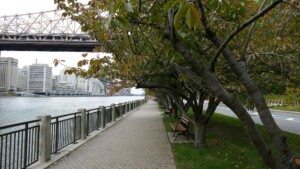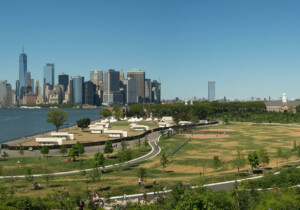The Cultural Landscape Foundation (TCLF) has released its Landslide 2019: Living in Nature report, which highlights 10 landscapes across the United States currently in danger due to climate change. One of those threatened places is the Gateway National Recreation Area (GNRA), otherwise recognized as the entrance to the New York Harbor which spans from Jamaica Bay in Queens to Staten Island and Sandy Hook, New Jersey.
Nearly 27,000 acres of islands, ponds, marshes, meadowlands, and historic structures make up the GNRA, which was designated by Congress as a U.S. National Recreation Area in 1972 and is managed under the National Parks Service (NPS). Ten million people visit the area each year to swim, hike, camp, boat, bird watch, and fish, making it the fourth-most popular national park.
It’s no secret that the coastline of the New York metropolitan region, which was severely damaged by Hurricane Sandy in 2012, has long been located in the way of potentially perilous weather. Particularly susceptible to flooding and sea-level rise, the GNRA, and residential neighborhoods around it, have suffered due to lack of, or slow, planning for the effects of climate change.
But that’s recently changed. After the storm hit exactly seven years ago, there have been significant reconstruction efforts and moves to buffer the city’s shoreline from future catastrophic events. In August, New York’s Governor Andrew Cuomo announced the Army Corps of Engineers (ACE) would build a $616 million seawall along Staten Island that will double as a multi-use elevated promenade. The project is a result of the ACE’s on-going study of coastal storm risk management in the New York-New Jersey Harbor. An interim report on its initial findings was released last February.
Despite this state-backed effort, it’s possible that there will be little support from the federal government in combating climate change. On Monday, President Trump announced he would pull the U.S. from the Paris climate accord. And last week over 400 local elected officials, including 13 from New Jersey, pressured Senate Majority Leader Mitch McConnell and House Speaker Nancy Pelosi to pass legislation that prioritizes top deferred maintenance issues within the National Parks Service’s looming, billion-dollar maintenance backlog. If passed, the Restore Our Parks Act and the Restore Our Parks (S. 500) and Public Lands Act (H.R. 1125) would invest up to $6.5 million over five years in national parks across the country—effectively bolstering them in the face of future inclement weather.
As the AH Herald reported, the GRNA alone currently suffers backlogged problems amounting to $123,286,570. Because of its size and unique makeup—connecting two states and three separate “units” as they’re called—the challenge of upkeep is monumental. In Brooklyn, the GRNA extends from John F. Kennedy International Airport to the Jamaica Bay Wildlife Refuge to Shirley Chisholm State Park, which is currently under development and will be the largest state park in New York City by next summer. Floyd Bennet Field, the former airfield listed on the National Register of Historic Places, is also included in the Jamaica Bay Unit, alongside Canarsie Pier, Fort Tilden, Breezy Point on the Rockaway Peninsula, and Jacob Riis Park, the beach and boardwalk outpost built by Robert Moses.
In the Staten Island unit of the GRNA, Fort Wardsworth, Miller Field, and Great Kills Park on the southeastern shore of the borough are at risk, while in the Sandy Hook unit in New Jersey, Fort Hancock, and Sandy Hook with its seven well-used beaches, salt marshes, and holly forest, are also in need of repair.
“As you read through TCLF’s annual Landslide and lament the loss of irreplaceable cultural and historical sites, get angry and then get busy. The planet needs you,” – Jonathan B. Jarvis, former director of the National Park Service – https://t.co/EyyJcCg0xG pic.twitter.com/XsChb0u9fI
— Charles Birnbaum (@TCLFdotORG) November 6, 2019











